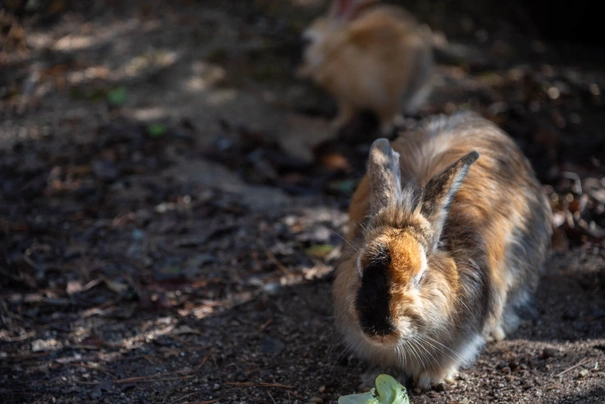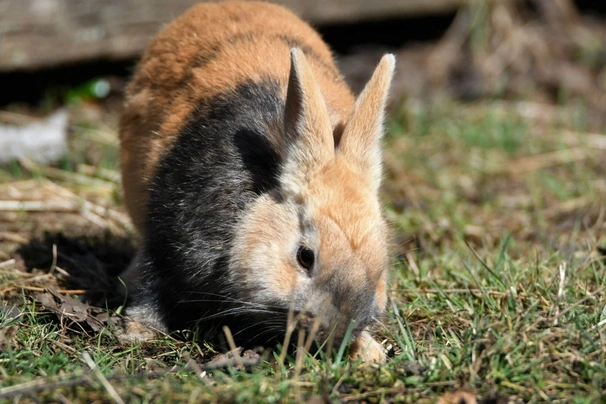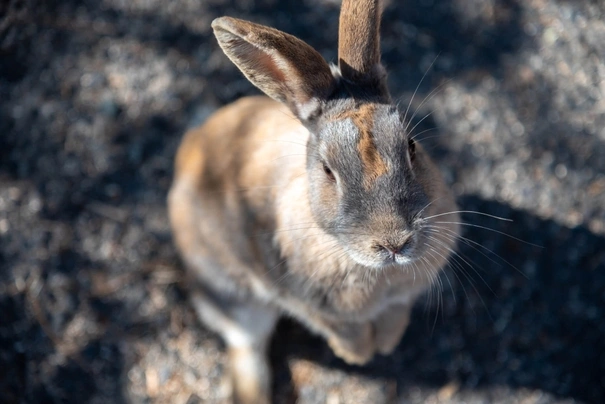Pets
Pets for studWanted petsBreedersAccessories & services
Knowledge hub
Support
Support & safety portalHarlequin
Introduction of the Harlequin
The Harlequin is a very popular breed of rabbit that is recognised by fanciers and breed associations for its colouring and markings rather than its fur type. Its colour is usually black and orange with absolutely no silvering allowed by the breed standard.
Many fanciers suggest that this Harlequin isn’t actually a breed, rather, it’s simply a colour and this is hotly debated in rabbit circles. Although the colourway is referred to as harlequin and this has been taken as the name of the breed, the Harlequin breed can also present in a ‘magpie’ colourway, which means white, rather than orange, is the second colour.
History of the Harlequin
One of the oldest breeds of rabbit, the Harlequin was developed in France in the 1880s by putting together the semi-wild Tortoiseshell Dutch rabbit that was popular at the time, with truly wild rabbits. The very first examples of the Harlequin closely resembled the Dutch, but the markings were said to be less desirable.
The first Harlequins were shown at International events in Paris in 1887 and made their way to England shortly afterwards. In England they were a popular shown animal thanks to their unusual markings, however they also became popular as a meat animal during the World War II.
In the US, where The Fancy, as rabbit enthusiasts refer to the showing industry, is incredibly popular, the Harlequin has fallen in and out of favour on a regular basis since the 1920s. The American Rabbit Breeders Association has dropped the breed and accepted it again many times, although at present it is recognised by the ARBA.
Appearance of the Harlequin
- Main colourways: blue, black, lilac, chocolate (all mixed with orange); black magpie, blue magpie, lilac magpie, chocolate magpie (all mixed with white)
- Average weight: 2-3kg
The traditional colour of the Harlequin is partly black (or one of the other accepted colours) and orange – the brighter the better. According to the standard, the Harlequin should display an equal amount of both colours and the head should show a ‘half and half’ marking. A true Japanese Harlequin (with orange as the second colour), should have ears of opposite colours and the face should also be divided down the middle with the opposite colours under each ear. The feet are also of alternate colours.
The colour can also appear as a ‘magpie’ variation, where the accepted colours of blue, chocolate, lilac and black are interspersed with an equal amount of white, rather than orange.
The Harlequin is a small rabbit with a broad head that’s also quite long. The ears are of a moderate length and stand erect.
Temperament of the Harlequin
The Harlequin is a gentle, curious little animal and therefore makes an ideal companion for children and adults alike. They’re a calm, inquisitive rabbit, but as their clown-like appearance would suggest, they do love to be the centre of attention and will thoroughly enjoy playtime with their owner.
As one of the more intelligent breeds, the Harlequin will appreciate lots of boxes and tubes to burrow into and climb on. They will also appreciate plenty of space – either in a large run or a secure area of garden in which to indulge their love of exploration and play will be welcomed. Whether you’re rabbit is to live indoors or out, his intelligence means he will love to play training games and will learn to come when called and can also be taught to use a litter tray, which is very useful if he’s going to live indoors!
Health of the Harlequin
Rabbits are susceptible to a number of problems so their living quarters, diet and overall hygiene and condition must be monitored carefully. Rodents’ teeth grow continually and must be kept worn down by a diet high in roughage – good quality hay and fibrous leaves and vegetables like kale, cabbage and dandelions will help with this. Overgrown molars and enamel spurs, if allowed to develop, can cause injuries in the mouth and make eating difficult. Symptoms of overgrown teeth including lethargy, runny eyes or nose and a lack of appetite.
Your rabbit should not be allowed to gain too much weight as overweight rabbits have difficulty grooming, making them prime candidates for flystrike. This is a nasty problem that occurs when flies, attracted to soiled areas of fur (usually around the rear end), lay their eggs in the dirty coat and the resulting maggots burrow under the rabbit’s skin. This causes great discomfort and can lead to infection.
Rabbits can also suffer with digestive problems too, and diarrhoea is common. A high-fibre diet with good hay, pellets and green leaves and plenty of clean, fresh water will help make sure he’s always got a happy tummy.
All rabbits should be treated regularly for worms, fleas and ticks and should also be vaccinated against myxomatosis and Viral Haemorrhagic Disease. Does not intended for breeding should be spayed to help guard against uterine cancer, which unfortunately is also common in rabbits.
Caring for the Harlequin
Rabbits make very good pets – they’re clever, can be affectionate and they’re playful. They can also live indoors our out depending on which you prefer. An indoor rabbit should be taught how to use a litter tray and given a suitably sized crate or cage where he can totally relax. Wires and cables should be kept out of his way; along with anything else you don’t want chewing! He will need regular access to the outdoors so provide him with a good-sized run or a secure area of garden in which he can indulge his love of exploration and running. If you’re considering getting a rabbit, it’s certainly worth thinking about getting two as they are social mammals and will appreciate the company. Never house a rabbit with a guinea pig as the larger rabbit could injure the smaller animal. Two neutered males or a neutered male and a female will get on best.
If he’s going to live in a hutch it should be weather and waterproof and positioned out of direct sun and wind. If you have a well-lit, well-ventilated shed putting the hutch inside is a good way to get him used to the elements while keeping him out of the worst of the weather. A plastic cover to put over the mesh front of the hutch is also a good idea if the hutch is located outdoors.
Any hutch should have a covered sleeping area where the rabbit can build a nest, and it should be lined with hardwood shavings and straw. The hutch should be cleaned out thoroughly once a week, with droppings removed daily.
A rabbit’s diet must comprise good quality hay, good rabbit pellets and a plentiful supply of fibrous green vegetables and leaves such as dandelion, carrot tops, kale and spring greens. He should also have access to clean, fresh water at all times.
Related adverts
See all
Harlequin baby bunnies
£70

BOTH SOLD 2 mini lops available now
£50



